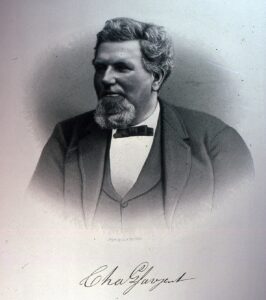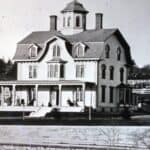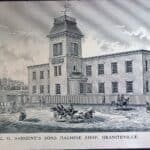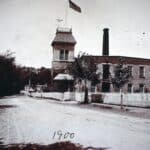A Builder and Inventor of Machinery for Cleaning and Preparing wool, cotton, hair and rags.
Sargent was born July 17, 1818 in Hillsboro, New Hampshire. Sargent was considered a valued member of the Westford community not only for his business pursuits, but his involvement in the town’s industrial growth. In 1908, Sargent was even deemed “the real founder of Graniteville” when the Graniteville school building was named after him.
for his business pursuits, but his involvement in the town’s industrial growth. In 1908, Sargent was even deemed “the real founder of Graniteville” when the Graniteville school building was named after him.
The son of a tailor, Sargent grew up working on neighboring farms in Hillsboro and learned a variety of trades, including cabinet and clock-making. When his employer’s business failed in 1838, however, young Sargent decided to move to Lowell, Massachusetts, working at the Lowell Machine Shop for three years. It was during this time that his interest in the machine business truly sparked, as he went on to take charge of all repairs at the Eagle Mills in West Chelmsford and later, spinning and combing at the Lowell Carpet company. In 1842, he married his wife, Harriet Reed, who was born in Westford, and gave birth to their five children.
Soon after, Sargent was involved with new factories entering the business, including one in 1845 that was designed for the manufacture of worsted. During this time, Sargent invented a burring machine, a tool that removes burrs, or rough edges, from metal machinery.
In 1852, Sargent began his efforts to enter the machine business himself, successfully starting Sargent and Lane on Market St. and Marve, Lane and Sargent on Fletcher St. It was also during this period that Sargent worked on his second invention, the Garnett wire and Garnett wire-wound cylinder. Although these businesses were successful, he was forced to abandon these efforts temporarily due to ill-health.
Sargent moved to Graniteville in 1854. At the time, the village was home to only an estimated four houses, with the Stony Brook Railroad newly placed. Originally deemed Stone Quarry, the village name was later changed to Graniteville at Sargent’s suggestion.
Here, in partnership with Francis A. Calvert, Sargent purchased a grist mill and saw mill in Graniteville in 1854, converting them into shops for cotton and wool machinery. Three years later, he formed a partnership with John Abbot to manufacture worsted yarn for the Abbot Worsted company but later sold his interest to Allan Cameron to focus on his machinery business, before both of these buildings burned down on Dec. 5, 1858. Later, in 1863, Sargent bought out Calvert’s interest in the firm and sold a portion to his son, Frederick G. Sargent, and the firm ultimately became a family business: Charles G. Sargent & Son.
Throughout his life, Sargent was the source of several inventions, including a wool-washing machine, burr picker, and wool dyeing machine. He was also heavily involved in the Westford community, having provided land and financial support for the construction of the Methodist church and served as the first President of trustees for the institution. At the time of his death, Sargent was also the director of the Prescott National Bank, the vice president of the Central Savings Bank, and a director in the building of the Nashua and Acton Railroad.
Sargent died July 16, 1878, at his seaside cottage in Salem.
Resources:
“A Biography of the Life of Charles Grandison Sargent by Frederick Sargent” Dec. 24 1928
United States Patent Office “Automatic Damper Operating Device for Drying Machines” Mar. 20 1928
“Westford Wardsmen” , Oct. 24. 1908.
Written By
Deepa Gautam
Summer Intern, Westford Museum 2024
Photo collection




Below are two articles from the collection of the Westford Museum and Historical Society
featuring the life and business of Charles G. Sargent
